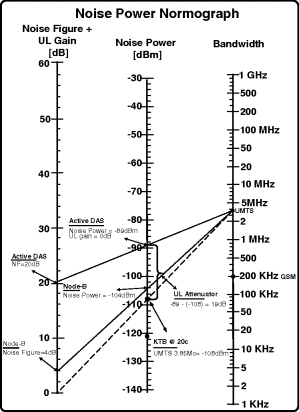10.5 Impact of External Noise Power
It is crucial to select the correct value for the UL attenuator between node B and the active system. The purpose of this attenuator is to minimize the UL noise power. However the correct value of the attenuator needs to be selected in order to have the minimum noise impact and not affect the UL (SNR) performance.
The ideal attenuator will be the difference between the noise power from the DAS and the KTB. The ‘noise power normograph’ in Figure 10.4 will help you to calculate the noise power in any given bandwidth, and thereby enable you to select the optimum UL attenuator. It is the standard noise calculations from Chapter 7, although the noise normograph might be easier to use. This is how to use the normograph.
Figure 10.4 Noise normograph, an easy way to calculate noise power

- The left graph – this is the reference point for the noise figure from the DAS plus the UL gain set in the system, so if your NF from the system is 12 dB, and you use 3 dB UL gain, you should select 15 dB as the reference.
- The right graph – this is the reference point for the RF bandwidth for the noise calculation, so for GSM you select 200 kHz for UMTS 3.84 Mc (Figure 10.4).
10.5.1 To Calculate the Noise Power
You select the RF bandwidth and the NF and draw a line between the two points; then the noise power is given by the point where this line crosses the center ...
Get Indoor Radio Planning: A Practical Guide for GSM, DCS, UMTS, HSPA and LTE, Second Edition now with the O’Reilly learning platform.
O’Reilly members experience books, live events, courses curated by job role, and more from O’Reilly and nearly 200 top publishers.

